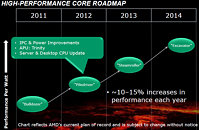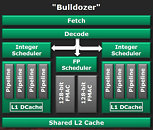qubit
Overclocked quantum bit
- Joined
- Dec 6, 2007
- Messages
- 17,865 (2.81/day)
- Location
- Quantum Well UK
| System Name | Quantumville™ |
|---|---|
| Processor | Intel Core i7-2700K @ 4GHz |
| Motherboard | Asus P8Z68-V PRO/GEN3 |
| Cooling | Noctua NH-D14 |
| Memory | 16GB (2 x 8GB Corsair Vengeance Black DDR3 PC3-12800 C9 1600MHz) |
| Video Card(s) | MSI RTX 2080 SUPER Gaming X Trio |
| Storage | Samsung 850 Pro 256GB | WD Black 4TB | WD Blue 6TB |
| Display(s) | ASUS ROG Strix XG27UQR (4K, 144Hz, G-SYNC compatible) | Asus MG28UQ (4K, 60Hz, FreeSync compatible) |
| Case | Cooler Master HAF 922 |
| Audio Device(s) | Creative Sound Blaster X-Fi Fatal1ty PCIe |
| Power Supply | Corsair AX1600i |
| Mouse | Microsoft Intellimouse Pro - Black Shadow |
| Keyboard | Yes |
| Software | Windows 10 Pro 64-bit |
The reviews are now out for AMD's brand new Bulldozer architecture, in the form of the Zambezi FX 8120 & FX 8150 processors and they don't paint a pretty picture of these flagship products. The chips use lots of power, run hot and significantly underperform compared to their Intel competition. On top of that, they are being marketed as 8 core processors, when they are actually 4 core with an advanced form of multi-threading, due to the siamesed nature of each dual processor module. Perhaps to counter this negative publicity and try to restore some faith in the AMD brand, they have released a roadmap for the planned improvements to the architecture, all the way to 2014 - an ambitious timeline, given how much and how unexpectedly things can change at the cutting edge of the technology world.


Looking at the chart, one can see that the various architectures Piledriver, Steamroller and Excavator all add up to between 30-50% projected improvement by 2014 (subject to change without notice, of course). These are all names designed to impart a tough-guy image to their products to give one the impression that they must perform very well, beating the competition into submission. Therefore, if they fail to perform competitively against Intel, those names will continue to be branding embarrassments like Bulldozer is, currently. As Intel is already 20-50% faster right now depending on the benchmark, how are these modest improvements possibly going to compete with Intel's future products? AMD has already had a change of management at the top recently, so we can only hope that the right CEO comes along and turns them around, otherwise they may end up not manufacturing x86 processors at all in future, possibly becoming a GPU company only.
The main problem with the current Bulldozer architecture is that it's very, very late to market. AMD started working on it four years ago in 2007, which is a very long time in the world of desktop processors, so AMD have effectively released a new "old" product. The two important things that it has going for it, are that it scales well with core count and clock speed - those 8GHz overclock marketing demos weren't completely without merit. What we need to see is AMD improving performance much more than the prediction slide they've released, more like 100% or more perhaps, which is not really such an unrealistic target to achieve in three years of design and process improvements. Perhaps discarding this whole architecture and starting afresh with fully discreet cores like on the Phenom might be the way forward? AMD has recently let go some of its top-level management, so perhaps their replacements can turn the company around?
So, even if AMD achieves this projected performance improvement and more, will it really be enough to counter Intel, or will Intel steamroller AMD's Bulldozer back into submission?
Source:X-bit labs and Bulldozer block diagram courtesy of Hexus' FX 8150 review.
View at TechPowerUp Main Site


Looking at the chart, one can see that the various architectures Piledriver, Steamroller and Excavator all add up to between 30-50% projected improvement by 2014 (subject to change without notice, of course). These are all names designed to impart a tough-guy image to their products to give one the impression that they must perform very well, beating the competition into submission. Therefore, if they fail to perform competitively against Intel, those names will continue to be branding embarrassments like Bulldozer is, currently. As Intel is already 20-50% faster right now depending on the benchmark, how are these modest improvements possibly going to compete with Intel's future products? AMD has already had a change of management at the top recently, so we can only hope that the right CEO comes along and turns them around, otherwise they may end up not manufacturing x86 processors at all in future, possibly becoming a GPU company only.
The main problem with the current Bulldozer architecture is that it's very, very late to market. AMD started working on it four years ago in 2007, which is a very long time in the world of desktop processors, so AMD have effectively released a new "old" product. The two important things that it has going for it, are that it scales well with core count and clock speed - those 8GHz overclock marketing demos weren't completely without merit. What we need to see is AMD improving performance much more than the prediction slide they've released, more like 100% or more perhaps, which is not really such an unrealistic target to achieve in three years of design and process improvements. Perhaps discarding this whole architecture and starting afresh with fully discreet cores like on the Phenom might be the way forward? AMD has recently let go some of its top-level management, so perhaps their replacements can turn the company around?
So, even if AMD achieves this projected performance improvement and more, will it really be enough to counter Intel, or will Intel steamroller AMD's Bulldozer back into submission?
Source:X-bit labs and Bulldozer block diagram courtesy of Hexus' FX 8150 review.
View at TechPowerUp Main Site
Last edited by a moderator:




 They come up with this? Alien got the better part of the deal.
They come up with this? Alien got the better part of the deal.
